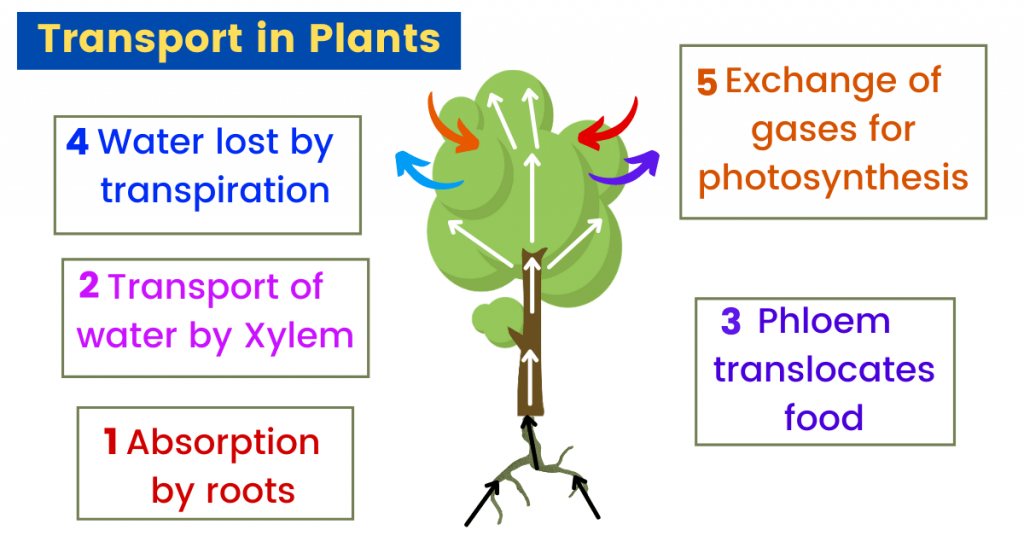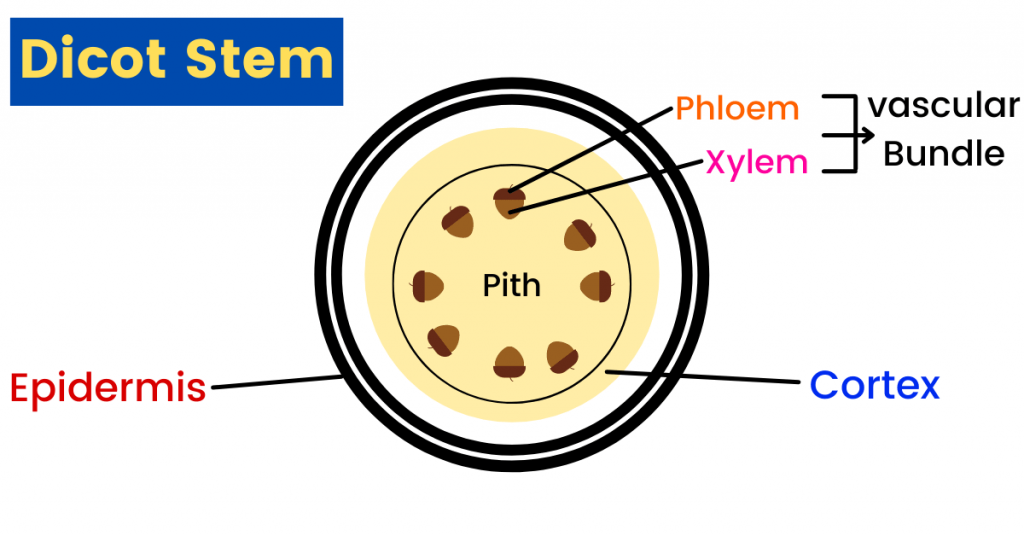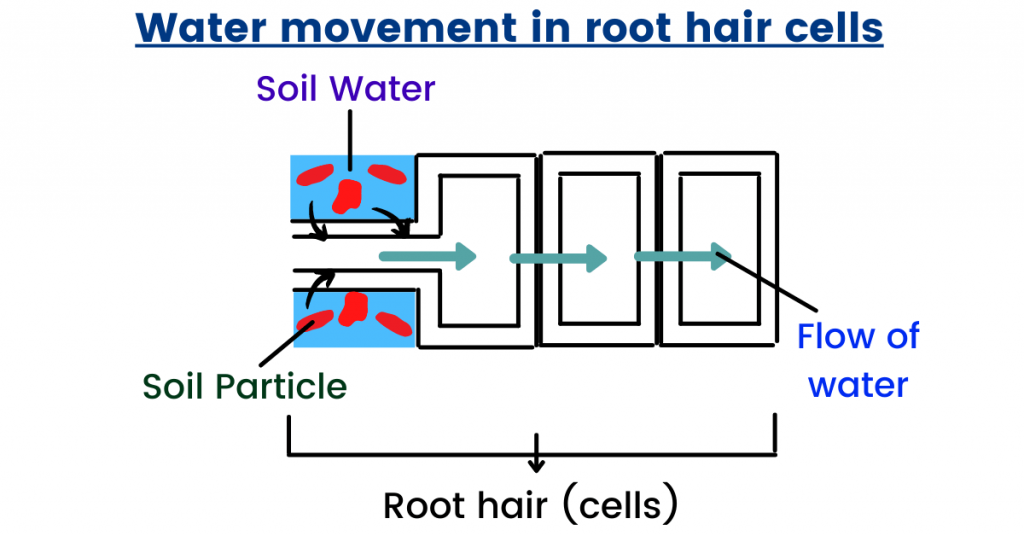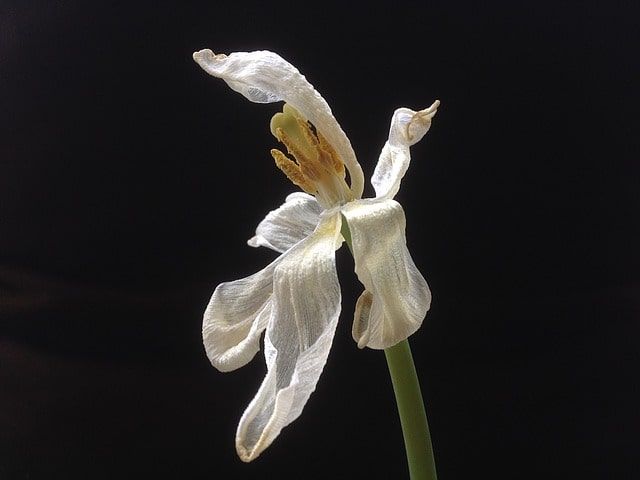Do you want to know about how transport in plants take place? The role of xylem and phloem in this mechanism, and some details about important topics such as transpiration and wilting?
We will discuss all these concepts in detail.
So, let’s dive straight into the topic.
Plants need water, mineral salts, food and necessary nutrients to survive. How is all this supplied to the plants? The simple answer to this is transportation.
Transportation is the mechanism through which flowering plants receive all the required materials that are necessary for their growth and development.

If we go into more details, we know that plants use carbon dioxide and water for photosynthesis. As a result, they produce glucose and oxygen. The raw materials, carbon dioxide and water are transported to the plants.
This was all about the introduction to this topic. Now, let’s discuss some other concepts of this topic in detail now without further introductions.
Transport in Vascular Tissues:
In vascular plants, we have vascular tissues (complex conducting tissues) that are formed by different types of cells. Xylem and Phloem are the primary components of this tissue.
These vascular tissues are arranged in vascular bundles. So basically, these vascular bundles contain xylem, phloem and some protective cells as well.
These components are responsible for the transport of water, mineral salts and food internally. But, how does this happen? Let me tell you all this, step-by-step.
Note: All the vascular tissues in a plant make up its vascular tissue system.
Xylem:
It is a transport tissue that transports water and mineral salts from the roots to the stem and leaves.
Basically, it a part of the transport mechanism in the plants, and it also provides mechanical support to the plant. This means that it prevents the plant from collapsing.
Do you anything about its structure? Let me explain the working of this tissue with the help of its structure!
- It contains long fibres that support the plant.
- Xylem vessels are hollow and continuous (so water easily flows through them).
- They lack protoplasm.
- These vessels have lignin (for the formation of cell walls and structural material) on them.
How does the structure help this tissue in carrying out its function (transport of mineral salts and water)?
The answer is that the lignified walls (of the vessels) and fibres, allow it to mechanically support the plant. This is the reason why they prevent the plant from collapsing.

Moreover, the water flows through these vessels very easily because the lumen is continuous (without a protoplasm). This ensures that there is no barrier to prevent the flow of water.
This takes us to another important topic which is about the phloem tissue. So, let’s talk about that in detail now.
Phloem Tissue:
It is responsible to translocate food from the leaves (made through photosynthesis) to all parts of the plants.
Note: Translocation in plants refers to the movement of food substances, such as sucrose and amino acids. In simple words, the transportation of food is known as translocation.
If we talk about the structure of phloem tissue, you should know the following details (although not all of this is required by your syllabus):
- Phloem is composed of conducting cells and other specialised cells such as phloem fibres, sieve tubes or companion cells.
- The manufactured food (amino acids and sucrose) travels in the sieve-like areas of the sieve tube.
- In the sieve tube cells, we have a thin layer of cytoplasm. Diffusion and active transport occur over here for the movement of food substances across the cytoplasm.
- Sieve cells depend upon companion cells for this process because sieve tubes do not contain vacuole and some other organelles.
If we talk about their location, the phloem tissues are located outside the xylem. But, we will take a look at this in detail as well.
This takes us to another important concept which is about the internal structure of the dicot stem and root.
Internal structure of dicot stem:
Dicotyledon (dicot in short) is one of the groups in which the flowering plants are categorised. The two groups in which plants are divided are:
- Monocots
- Dicots
The dicotyledonous stem has a well-defined epidermis, cuticle and a layer of the dermis. The xylem and phloem are grouped together which forms vascular bundles.

Note: The plant cuticle covers the epidermis of leaves because it is a protective layer. It also prevents evaporation of water from the stem.
In dicot stems, you will notice that the vascular bundles are arranged in a ring. The central region, located inside the cambium ring, is known as pith.
But, how do you identify a dicot stem? Here is the complete procedure which I personally use to easily identify a dicot stem!
- Look for a well-defined epidermis and cuticle.
- Identify stem hairs after locating the epidermis and cuticle.
- Look at the arrangement of the xylem and phloem (they must be arranged in a ring to form a vascular bundle).
- Finally, identify the endodermis which is the innermost layer of the cortex (the region between the epidermis and vascular bundles).
This takes us to a similar topic which is about the internal structure of a dicotyledonous (dicot) root.
Internal structure of a dicot root:
The root is the part of a vascular plant that is underground. Their main function is to absorb water and mineral salts and transport them to the stem. They are also responsible for the storage of reserved foods.
Further reading:
Respiration explained in simple words | GCE O Level Biology
Excretion Made Simple | GCE O Level (5090)
If we talk about the internal structure of a dicot root, it has a taproot structure (thick root with further branches that grow deep into the ground).
Unlike the dicotyledonous stem, the xylem and phloem form separate patches (they are not bundled together). Moreover, the cortex is extensive and large in roots (because it acts as a storage organ). The cortex is made up of thin-walled cells.

In a dicot root, the epidermis (single layer of cells) have hairy bodies (known as the piliferous layer). The function of these root hairs is to increase the efficiency for the absorption of water and minerals (due to their large surface area).
You should also know that the endodermis inside the root regulates the flow of ions and water. At the centre, there is a pith as well which may be absent as well. To summarise, you should locate the following structures in the diagram of a transverse section of a dicot root.
- Xylem and Phloem
- Cortex
- Piliferous layer
- Root hairs
- Endodermis
This takes us to the discussion about the structure and adaption of the root hair cells.
How are root hair cells adapted to their function?
Root hair cells are the tubular root cells and, they are found at the tip of the plant’s roots. Their function is to absorb water and other required minerals from the soil (through osmosis and active transport).
But, how do they do they play a part in transport in plants?
They have a large surface area to volume ratio. This allows them to speed up the process of the uptake of water and ions (the process of absorption).
Moreover, the sap in the root hair cells is relatively a stronger solution of salts and sugars. This means that the water potential in the root hair cells is comparatively less than the soil solution. As a result, water moves from the soil solution to the root hair cells.
This is because osmosis occurs over here. Osmosis is the movement of water molecules, from a region of higher water potential to a region of lower water potential, down a concentration gradient.
You should also know that root hair cells are long and narrow. This is also the reason why they have a greater surface area to volume ratio (which increases the rate of absorption).

In short, these are the characteristics, that you should know, allow root hair cells to carry out their function.
- They are long and narrow.
- They have a greater surface area to volume ratio (allow it to absorb more water and mineral ions).
- Their sap is concentrated by salts, sugars and amino acids. So water moves from the soil solution via osmosis.
- Since they are living, they provide energy to carry out active transport.
Let me tell you that active transport is the movement of molecules from a region of lower concentration to a region of a higher concentration (against the concentration gradient). So, what does this mean?
This means that although the sap solution of the root hair cells is concentrated, yet it absorbs minerals from the soil through active transport. Cool, isn’t it?
How does water enter a plant?
Now you might be wondering, what was the purpose of all this discussion? This information will help you to understand the complete process which causes water to enter a plant.
Let me tell you how, step-by-step.
Firstly, the root hair cells absorb water from the soil solution through osmosis. Secondly, the water passes from the root hair cells to the inner cell (of the plant). What happens next?
Then, the inner cell has higher water potential than the other cells of the plant. Therefore, water moves to the other cell (located next to it) through osmosis (because they have comparatively less water). This process occurs from one cell to the other.
But, when it comes to other minerals, there is something else that you should also know.
Both diffusion and active transport occur during the absorption of mineral ions.
This is how water and mineral ions enter the plant. With this, it is time to move on to another topic which is transpiration and wilting.
Transpiration:
The movement of water through the plant and its evaporation from its aerial parts (such as flowers, leaves and stem) is known as transpiration. In simple words, it is the loss of water, especially through the stomata of the leaves.
In fact, water is vital for plants but, very little amount of water that is taken by the roots is used by the plant for growth and development. But before going into more details, you should be familiar with the following terms:
Root pressure:
This osmotic pressure in the root hair cells allows the water to flow from the stem to the leaves. Basically, when water moves into the xylem vessels through osmosis, it moves upward.
This upward movement of water is known as the root pressure. This process requires metabolic energy as well.
Capillary action:
You should also know that the capillary action also allows water to move upwards. But, how does this happen? Let me tell you how this process takes place.
In simple words, the molecules of the liquid are attracted to the molecules of the solid. So, capillary action is the movement of liquid molecules (along with a solid). If this is confusing you, let me say that in this process, water moves inside a fine capillary tube.
This movement inside the capillary tube plays an important role in the upward movement of water molecules, along with the root pressure. Now, let’s talk about transpiration pull as well.
Transpiration pull:
It is a force that allows water to move from the roots to the leaves. What actually happens is that when water is being lost through transpiration, there is a suction force. This suction force causes more water to move upwards.
So in this way, the root pressure, capillary action and transpiration pull work together to move the water upwards (which is then lost through transpiration via stomata). Now when you know about these basic terms, let’s move back to the topic.
Why do plants need transpiration?
- Fresh water and minerals are drawn from the soil. Do you know why?
This is because transpiration causes a negative pressure gradient. This means that the water potential in the plant is lowered. Therefore, water and mineral ions move from the soil solution into the plant (by root hair cells).
Do you this, the plant is continuously supplied by fresh nutrients as excess water is removed.
- Transpiration cools down the plant.
This is because when water evaporates, the heat energy is also lost. I like to explain this with reference to humans. In the topic of transport in animals, we learned that when the body temperature increases, sweating causes the body to cool down.
So, you can take transpiration as sweating for the plants. As a result, the heat bearing particles are removed, causing the plant to cool down.
- Transpiration plays a major role in photosynthesis. Let me tell you how.
For photosynthesis, the plants need water and carbon dioxide to make food (glucose) and oxygen. But, how is water obtained by the plant?
This is where transpiration comes. Due to this process, water moves up the plant to the leaves where photosynthesis takes place. So in this way, water is taken up by the structures where photosynthesis has to occur.
Recall the equation for photosynthesis:
6CO2 + 6H2O → C6H12O6 + 6O2
Note: Recall the three major processes that cause water to move from the roots to the leaves.
- It provides water to keep the cell turgid (a cell that has turgor pressure). This supports the plant.
Wilting:
It is the condition in which a plant becomes non-rigid. In simple words, they become limp and flaccid due to many factors such as heat, disease and extra loss of water.

So basically, when a plant wilts, it rolls and folds up.
This happens when the rate of absorption of water is less than the rate of loss of water. If a plant wilts permanently, it can die. You should also know some advantages and disadvantages of wilting as well.
Advantages and disadvantages of wilting:
It prevents the plant from losing more water as the stomata are closed. Moreover, when the leaves fold up, their exposure to sunlight is reduced. As a result, less surface area is exposed which ultimately reduces the rate of transpiration.
So, you can also say that this process plays a role in the survival of the plant.
Moving on to the disadvantages, as I mentioned earlier as well, permanent wilting can cause the death of a plant.
The rate of photosynthesis is reduced because the stomata are closed (so the exchange of gases is disturbed). Therefore, the amount of carbon dioxide entering the plant is also lowered.
These were some basic points which you should know about wilting.
Factors affecting transpiration:
The rate of transpiration is affected by the following factors:
- Temperature
- Light
- Wind
- Humidity
Let me explain these factors to you now.
Temperature:
The higher the temperature, the greater the rate of transpiration. This is because the plant will have to lose more water (to cool down from the heat).
In simple words, evaporation increases with greater temperature. So, transpiration also increases (to cool down the plant).
Light:
As the light intensity increases, the rate of transpiration also increases. This is because, during the day, stomata open and becomes wider.
This allows transpiration to take place. At night, there is less light so the stomata close. As a result, the rate of transpiration is also lowered.
Wind:
The greater the wind around a plant, the higher the rate of transpiration. You should know the reason for this as well.
This is because it is easier for water to evaporate in dry air as compared to saturated air. So due to wind, the saturated air is replaced with dryer air. As mentioned above, the rate of transpiration in the dryer air will increase.
For an experiment, you can find out the rate of transpiration of a plant. Then place a fan around the plant. You will notice that the rate of transpiration will increase.
Humidity:
If the humidity of the air (amount of water vapours) increase, the rate of transpiration decreases. This is because water moves form higher to lower concentration.
So, greater humidity means that the air is saturated. As a result, less water will evaporate from the plant. However, if the humidity is low, transpiration will be more because of the presence of dry air.
These are some of the factors that affect the rate of transpiration.
Conclusion:
With this, our article about the transport in plants has come to an end. I have explained all the important concepts in this topic, such as the structure and function of xylem vessels and phloem.
You should practise plenty of past paper questions regarding this topic, because it is very important from examination point of view. Thank you very much for reading and staying with me till the end.
Stay tuned for more! But before going, which concept from this topic was the most interesting? Did you find this topic easy? I will appreciate your thoughts.
